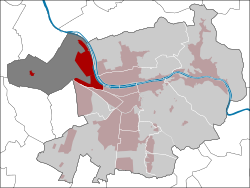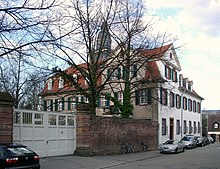Wieblingen
|
Wieblingen district of Heidelberg |
|
|---|---|
| Coordinates | 49 ° 25 '43 " N , 8 ° 38' 46" E |
| surface | 14.31 km² |
| Residents | 9773 (2010) |
| Population density | 683 inhabitants / km² |
| District number | 009 |
| structure | |
| Townships |
|
| Source: Page no longer available , search in web archives: City of Heidelberg (PDF; 143 kB) | |
The Heidelberg district of Wieblingen is located in the west of the city on the left bank of the Neckar . Wieblingen also includes the Ochsenkopf and Grenzhof settlements .
history
Wieblingen was first mentioned as Wibilinga in 767 in the Lorsch Codex when it was donated to the Lorsch Abbey. Numerous other mentions in deeds of donation in favor of the monastery followed. Commercial fishing died out during the industrial revolution and the first factories were built, including the Wieblinger Mühle .
In 1920 Wieblingen was incorporated into Heidelberg . More than 80 years later, in 2003, around 9,806 people lived in Wieblingen. That corresponded to 7.5 percent of the 130,234 inhabitants of Heidelberg.
Infrastructure
The Wieblingen Center is Elisabeth-von-Thadden-Platz, named after the reform pedagogue and resistance fighter against National Socialism Elisabeth von Thadden , who founded the school named after her in Wieblingen in 1927. The Heidelberg Waldorf School is located on the western edge of the village .
In Wieblingen is also the seat of the SRH with the technical schools and the SRH Hochschule Heidelberg , a vocational support organization and the Kurpfalzkrankenhaus Heidelberg.
At the end of September 2006, the Heidelberg tax office moved from Weststadt to Wieblingen at Maaßstrasse 32.
The Heidelberg-Wieblingen transmitter of the AFN Heidelberg was on the edge of Wieblingen . With a 65-meter-high tubular steel mast, it served to broadcast AFN programs on medium wave and VHF. The transmitter was switched off at the end of April 2014.
Educational institutions
- The Elisabeth von Thadden School located in Wieblingen is a private school . It was founded in 1927 by Elisabeth von Thadden as a Protestant rural education home for girls. After the National Socialists executed Elisabeth von Thadden in 1944, friends of hers continued the school as a boarding school for girls. Boys have been attending school since 1982. The boarding school was abolished in 1992.
- Froebel School (primary school)
- The Free Waldorf School Heidelberg, a state-recognized, general education school (grades 1–13) in an independent, non-profit organization. Furthermore, there is a day-care center based on Waldorf education on site.
- The Marie Baum School
- The Johannes Gutenberg School
- The Carl-Bosch-Schule is a vocational school in the commercial-technical direction and offers the following courses:
- professional school
- Vocational school
- Vocational college
- Master school for orthopedic technology
- Technical college for technology
- Technical high school (with the technology and information technology trains)
Churches
A church in Wieblingen is mentioned as early as 796. The Gothic building was erected in the 15th century, the choir and tower of which are still standing today and which is now used as the chapel of the Elisabeth von Thadden School. This church was consecrated to Saints Valentine and Bartholomew in 1496. It has been used as a simultaneous church since the Reformation and was left to the Reformed in 1705. From 1744 to 1746 a new Catholic church was built, the baroque St. Bartholomew Church on Mannheimer Straße.
At the turn of the 20th century, the churches of both denominations became too small for the larger congregations. The Protestants bought a building plot in the north-western corner of the palace park in exchange for the old church. In 1906 the neo-Gothic cruciform church designed by Hermann Behaghel , Baden's senior building officer, was inaugurated.
The planned larger Catholic Church initially prevented the First World War and the subsequent inflation. After the Second World War , a new rectory was built next to the old cemetery and in 1955/56 the new one, again dedicated to St. Bartholomäus, parish church built. The design came from the archbishop's architect Manfred Schmitt-Fiebig . The modern building with the separate campanile was initially rejected by the community.
More recently, the church buildings of other denominations have been added in Wieblingen: churches of the New Apostolic Church , the Church of Jesus Christ of Latter-day Saints and the St. Luke Church of the Christian Community in Heidelberg.
politics
The Wieblingen district advisory board is composed as follows:
| Party / list | 2019 |
|---|---|
| Green | 4th |
| CDU | 2 |
| SPD | 2 |
| The left | 1 |
| BL | 1 |
| GAL | 1 |
| "The Heidelberg" | 1 |
| FDP | 1 |
| AfD | 1 |
Famous residents
- Karl Gutzkow (1811–1878), writer, lived in Wieblingen Castle in 1874/1875
- Christian Henn (* 1964), former professional cyclist
- Dirk Niebel (* 1963), politician and 2009-2013 Development Minister (FDP), reserve officer
literature
- Hans Gercke: Churches in Heidelberg . Schnell und Steiner publishing house, Regensburg, 1st edition 2011 ( ISBN 978-3-7954-2413-8 ).
- W. Petschan: 50 years of St. Bartholomew. Catholics in Wieblingen celebrated their church anniversary . In: Church on the Way , No. 11, December 2006.
- Franz Sobkowiak: Wieblinger families before 1900 ( Ortssippenbuch Wieblingen, now Heidelberg-Wieblingen) . Lahr-Dinglingen: Interest group Badischer Ortssippenbücher 1990 (= Badische Ortssippenbücher 60), processed period 1698–1900
Web links
Individual evidence
- ↑ Minst, Karl Josef [transl.]: Lorscher Codex (Volume 2), Certificate 697, February 27, 767 - Reg. 114. In: Heidelberger historical stocks - digital. Heidelberg University Library, p. 257 , accessed on January 3, 2018 .
- ↑ List of places for the Lorsch Codex , Heidelberg-Wieblingen, Archivum Laureshamense - digital, Heidelberg University Library.
- ^ City of Heidelberg - District Advisory Council Wieblingen. Retrieved December 11, 2019 .
- ↑ Cf. Christof Körner: A Gutzkow memory. In: Heidelberger Tageblatt. General indicator. No. 67, March 20, 1911, p. 2.





